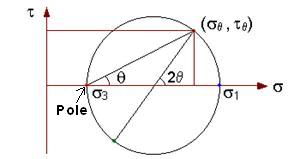Soils consist of individual particles that can slide and roll relative to one another. Shear strength of a soil is equal to the maximum value of shear stress that can be mobilized within a soil mass without failure taking place.
The shear strength of a soil is a function of the stresses applied to it as well as the manner in which these stresses are applied. A knowledge of shear strength of soils is necessary to determine the bearing capacity of foundations, the lateral pressure exerted on retaining walls, and the stability of slopes.
Mohr Circle of Stresses
In soil testing, cylindrical samples are commonly used in which radial and axial stresses act on principal planes. The vertical plane is usually the minor principal plane whereas the horizontal plane is the major principal plane. The radial stress (sr) is the minor principal stress (s3), and the axial stress (sa) is the major principal stress (s1).

To visualise the normal and shear stresses acting on any plane within the soil sample, a graphical representation of stresses called the Mohr circle is obtained by plotting the principal stresses. The sign convention in the construction is to consider compressive stresses as positive and angles measured counter-clockwise also positive.

Draw a line inclined at angle ![]() with the horizontal through the pole of the Mohr circle so as to intersect the circle. The coordinates of the point of intersection are the normal and shear stresses acting on the plane, which is inclined at angle
with the horizontal through the pole of the Mohr circle so as to intersect the circle. The coordinates of the point of intersection are the normal and shear stresses acting on the plane, which is inclined at angle ![]() within the soil sample.
within the soil sample.
Normal stress ![]()
Shear stress ![]()
The plane inclined at an angle of ![]() to the horizontal has acting on it the maximum shear stress equal to
to the horizontal has acting on it the maximum shear stress equal to ![]() , and the normal stress on this plane is equal to
, and the normal stress on this plane is equal to ![]() .
.
The plane with the maximum ratio of shear stress to normal stress is inclined at an angle of ![]() to the horizontal, where a is the slope of the line tangent to the Mohr circle and passing through the origin.
to the horizontal, where a is the slope of the line tangent to the Mohr circle and passing through the origin.